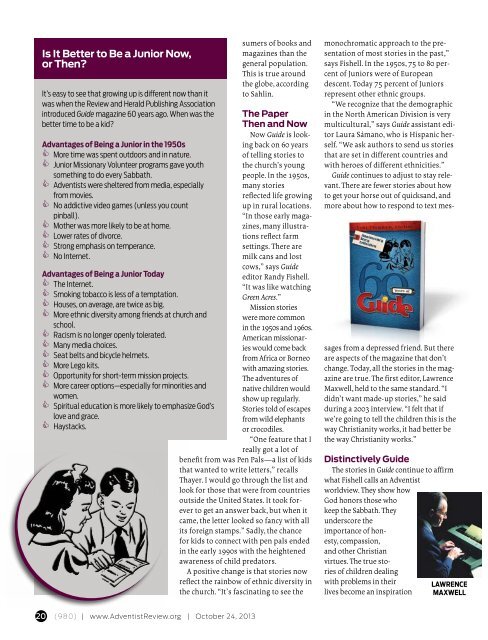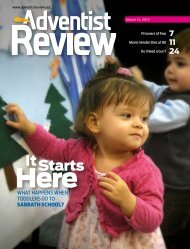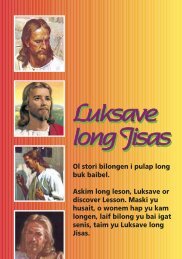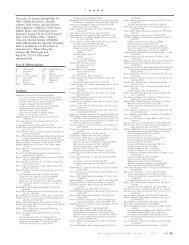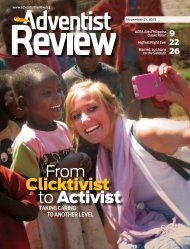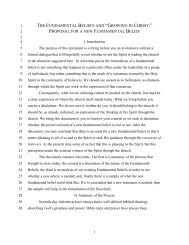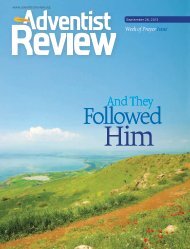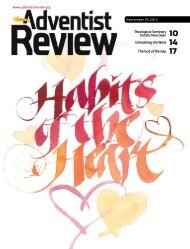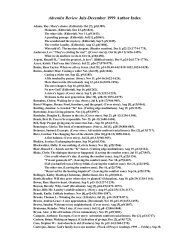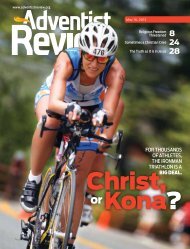Download PDF - Adventist Review
Download PDF - Adventist Review
Download PDF - Adventist Review
- No tags were found...
Create successful ePaper yourself
Turn your PDF publications into a flip-book with our unique Google optimized e-Paper software.
Is It Better to Be a Junior Now,<br />
or Then?<br />
It’s easy to see that growing up is different now than it<br />
was when the <strong>Review</strong> and Herald Publishing Association<br />
introduced Guide magazine 60 years ago. When was the<br />
better time to be a kid?<br />
Advantages of Being a Junior in the 1950s<br />
&&<br />
More time was spent outdoors and in nature.<br />
&&<br />
Junior Missionary Volunteer programs gave youth<br />
something to do every Sabbath.<br />
&&<br />
<strong>Adventist</strong>s were sheltered from media, especially<br />
from movies.<br />
&&<br />
No addictive video games (unless you count<br />
pinball).<br />
&&<br />
Mother was more likely to be at home.<br />
&&<br />
Lower rates of divorce.<br />
&&<br />
Strong emphasis on temperance.<br />
&&<br />
No Internet.<br />
Advantages of Being a Junior Today<br />
&&<br />
The Internet.<br />
&&<br />
Smoking tobacco is less of a temptation.<br />
&&<br />
Houses, on average, are twice as big.<br />
&&<br />
More ethnic diversity among friends at church and<br />
school.<br />
&&<br />
Racism is no longer openly tolerated.<br />
&&<br />
Many media choices.<br />
&&<br />
Seat belts and bicycle helmets.<br />
&&<br />
More Lego kits.<br />
&&<br />
Opportunity for short-term mission projects.<br />
&&<br />
More career options—especially for minorities and<br />
women.<br />
&&<br />
Spiritual education is more likely to emphasize God’s<br />
love and grace.<br />
&&<br />
Haystacks.<br />
sumers of books and<br />
magazines than the<br />
general population.<br />
This is true around<br />
the globe, according<br />
to Sahlin.<br />
The Paper<br />
Then and Now<br />
Now Guide is looking<br />
back on 60 years<br />
of telling stories to<br />
the church’s young<br />
people. In the 1950s,<br />
many stories<br />
reflected life growing<br />
up in rural locations.<br />
“In those early magazines,<br />
many illustrations<br />
reflect farm<br />
settings. There are<br />
milk cans and lost<br />
cows,” says Guide<br />
editor Randy Fishell.<br />
“It was like watching<br />
Green Acres.”<br />
Mission stories<br />
were more common<br />
in the 1950s and 1960s.<br />
American missionaries<br />
would come back<br />
from Africa or Borneo<br />
with amazing stories.<br />
The adventures of<br />
native children would<br />
show up regularly.<br />
Stories told of escapes<br />
from wild elephants<br />
or crocodiles.<br />
“One feature that I<br />
really got a lot of<br />
benefit from was Pen Pals—a list of kids<br />
that wanted to write letters,” recalls<br />
Thayer. I would go through the list and<br />
look for those that were from countries<br />
outside the United States. It took forever<br />
to get an answer back, but when it<br />
came, the letter looked so fancy with all<br />
its foreign stamps.” Sadly, the chance<br />
for kids to connect with pen pals ended<br />
in the early 1990s with the heightened<br />
awareness of child predators.<br />
A positive change is that stories now<br />
reflect the rainbow of ethnic diversity in<br />
the church. “It’s fascinating to see the<br />
monochromatic approach to the presentation<br />
of most stories in the past,”<br />
says Fishell. In the 1950s, 75 to 80 percent<br />
of Juniors were of European<br />
descent. Today 75 percent of Juniors<br />
represent other ethnic groups.<br />
“We recognize that the demographic<br />
in the North American Division is very<br />
multicultural,” says Guide assistant editor<br />
Laura Sámano, who is Hispanic herself.<br />
“We ask authors to send us stories<br />
that are set in different countries and<br />
with heroes of different ethnicities.”<br />
Guide continues to adjust to stay relevant.<br />
There are fewer stories about how<br />
to get your horse out of quicksand, and<br />
more about how to respond to text messages<br />
from a depressed friend. But there<br />
are aspects of the magazine that don’t<br />
change. Today, all the stories in the magazine<br />
are true. The first editor, Lawrence<br />
Maxwell, held to the same standard. “I<br />
didn’t want made-up stories,” he said<br />
during a 2003 interview. “I felt that if<br />
we’re going to tell the children this is the<br />
way Christianity works, it had better be<br />
the way Christianity works.”<br />
Distinctively Guide<br />
The stories in Guide continue to affirm<br />
what Fishell calls an <strong>Adventist</strong><br />
worldview. They show how<br />
God honors those who<br />
keep the Sabbath. They<br />
underscore the<br />
importance of honesty,<br />
compassion,<br />
and other Christian<br />
virtues. The true stories<br />
of children dealing<br />
with problems in their<br />
lives become an inspiration<br />
Lawrence<br />
Maxwell<br />
20 (980) | www.<strong>Adventist</strong><strong>Review</strong>.org | October 24, 2013


